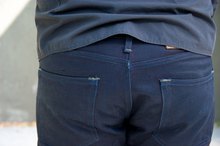How to Identify a Pulled Rib Muscle
Rib cages and the muscles surrounding the ribs are prone to injury. Once you injure them, sometimes it is difficult to tell whether you have broken a bone or pulled a muscle. Telling the difference, however, is necessary for receiving the correct treatment. Although in the same general area, a bone injury on the rib cage is treated differently than a pulled muscle and a pulled muscle differently than even a torn muscle. Knowing the difference can help you decide whether you need to go to a doctor and help find the correct treatment for a faster healing process.
If you are experiencing serious medical symptoms, seek emergency treatment immediately.
Think of how you got the injury. Pulled rib muscles most often occur during a sport where your body is twisted forcefully. Golf and tennis are two of the sports that most often cause this injury along with football, basketball and baseball. If you received your injury in an impact situation, you are more likely to have a bruised or broken rib.
How Does a Physical Therapist Fix a Stuck Rib?
Learn More
Feel between the ribs with your fingers in the general area of pain. If it is a pulled rib muscle the tenderness will be between instead of on the ribs.
Eliminate any of the other, more serious rib injuries. Severe pain will indicate a broken rib or a separated rib. If you have pain while breathing this also indicates a separated rib as opposed to a pulled muscle. These injuries will take longer to heal 1.
Warnings
If you think you have one or more broken ribs, seek medical help immediately. Another blow to the rib cage could cause further injury to the ribs or puncture a lung.
Related Articles
References
- Better Health Channel: Rib Injuries
- Hussain A, Burns B. Anatomy, Thorax, Wall. [Updated 2018 Dec 9]. In: StatPearls [Internet]. Treasure Island (FL): StatPearls Publishing; 2019 Jan-. Available from: https://www.ncbi.nlm.nih.gov/books/NBK535414/
- Graeber GM, Nazim M. The anatomy of the ribs and the sternum and their relationship to chest wall structure and function. Thorac Surg Clin. 2007;17(4):473-89, vi.
- Donley ER, Loyd JW. Anatomy, Thorax, Wall Movements. [Updated 2019 Feb 10]. In: StatPearls [Internet]. Treasure Island (FL): StatPearls Publishing; 2019 Jan-. Available from: https://www.ncbi.nlm.nih.gov/books/NBK526023/
- Majercik S, Pieracci FM. Chest Wall Trauma. Thorac Surg Clin. 2017;27(2):113-121.
- Talbot BS, Gange CP, Chaturvedi A, Klionsky N, Hobbs SK, Chaturvedi A. Traumatic Rib Injury: Patterns, Imaging Pitfalls, Complications, and Treatment. Radiographics. 2017;37(2):628-651.
- Miller TL, Harris JD, Kaeding CC. Stress fractures of the ribs and upper extremities: causation, evaluation, and management. Sports Med. 2013;43(8):665-74.
- Khoriati AA, Rajakulasingam R, Shah R. Sternal fractures and their management. J Emerg Trauma Shock. 2013;6(2):113–116. doi:10.4103/0974-2700.110763
- Perera TB, Daley BJ. Flail Chest. [Updated 2018 Dec 24]. In: StatPearls [Internet]. Treasure Island (FL): StatPearls Publishing; 2019 Jan-. Available from: https://www.ncbi.nlm.nih.gov/books/NBK534090/
- Kent R, Woods W, Bostrom O. Fatality risk and the presence of rib fractures. Ann Adv Automot Med. 2008;52:73–82.
- Flores-funes D, Lluna-llorens AD, Jiménez-ballester MÁ, et al. Is the number of rib fractures a risk factor for delayed complications? A case-control study. Eur J Trauma Emerg Surg. 2018;
- Hanak V, Hartman TE, Ryu JH. Cough-induced rib fractures. Mayo Clin Proc. 2005;80(7):879-82.
- Park S. Clinical Analysis for the Correlation of Intra-abdominal Organ Injury in the Patients with Rib Fracture. Korean J Thorac Cardiovasc Surg. 2012;45(4):246–250. doi:10.5090/kjtcs.2012.45.4.246
- Bulloch B, Schubert CJ, Brophy PD, Johnson N, Reed MH, Shapiro RA. Cause and clinical characteristics of rib fractures in infants. Pediatrics. 2000;105(4):E48.
- Tulay CM, Yaldiz S, Bilge A. Do we really know the duration of pain after rib fracture?. Kardiochir Torakochirurgia Pol. 2018;15(3):147–150. doi:10.5114/kitp.2018.78437
- Bemelman M, de Kruijf MW, van Baal M, Leenen L. Rib Fractures: To Fix or Not to Fix? An Evidence-Based Algorithm. Korean J Thorac Cardiovasc Surg. 2017;50(4):229–234. doi:10.5090/kjtcs.2017.50.4.229
- Fagevik Olsén M, Slobo M, Klarin L, Caragounis EC, Pazooki D, Granhed H. Physical function and pain after surgical or conservative management of multiple rib fractures - a follow-up study. Scand J Trauma Resusc Emerg Med. 2016;24(1):128. Published 2016 Oct 28. doi:10.1186/s13049-016-0322-4
- Patel RA, Wilson RF, Patel PA, Palmer RM. The effect of smoking on bone healing: A systematic review. Bone Joint Res. 2013;2(6):102–111. Published 2013 Jun 14. doi:10.1302/2046-3758.26.2000142
- Evman S, Kolbas I, Dogruyol T, Tezel C. A Case of Traumatic Flail Chest Requiring Stabilization with Surgical Reconstruction. Thorac Cardiovasc Surg Rep. 2015;4(1):8–10. doi:10.1055/s-0035-1558433
- Bhavnagri SJ, Mohammed T-LH. When and how to image a suspected broken rib. Cleveland Clinic Journal of Medicine. 2009;76(5):309-314. DOI: 10.3949/ccjm.76a.08026
- Jong MBD, Kokke MC, Hietbrink F, Leenen LPH. Surgical Management of Rib Fractures: Strategies and Literature Review. Scandinavian Journal of Surgery. 2014;103(2):120-125. DOI: 10.1177/1457496914531928
- Senekjian L, Nirula R. Rib Fracture Fixation. Critical Care Clinics. 2017;33(1):153-165. DOI: 10.1016/j.ccc.2016.08.009
- Wanek S, Mayberry JC. Blunt thoracic trauma: flail chest, pulmonary contusion, and blast injury. Critical Care Clinics. 2004;20(1):71-81. DOI: 10.1016/s0749-0704(03)00098-8
Warnings
- If you think you have one or more broken ribs, seek medical help immediately. Another blow to the rib cage could cause further injury to the ribs or puncture a lung.
Writer Bio
Sarah Morse has been a writer since 2009, covering environmental topics, gardening and technology. She holds a bachelor's degree in English language and literature, a master's degree in English and a master's degree in information science.







